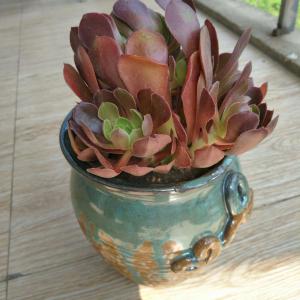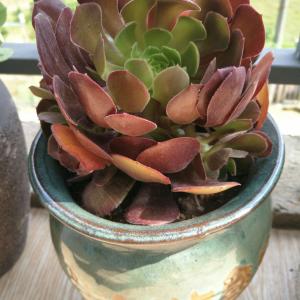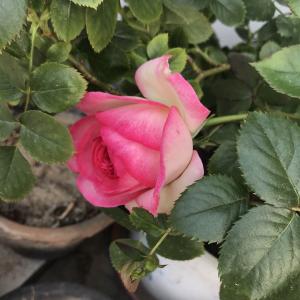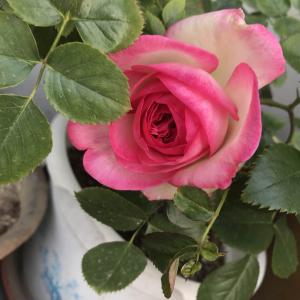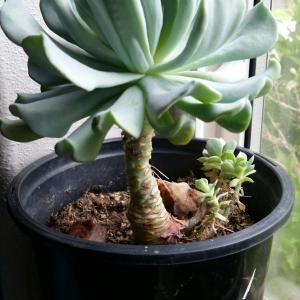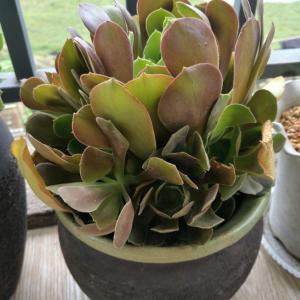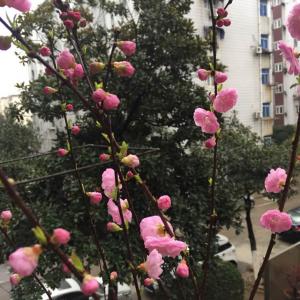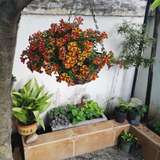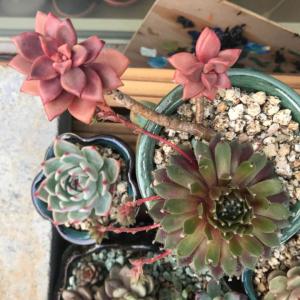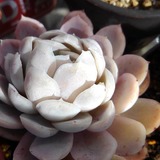成长记
Naisk
2018年04月25日
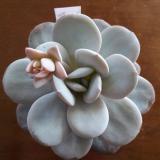
The wind threw them off the shelf, I kept the broken one and sold the 3 other. Two heads are now growing :)


0
0
文章
Miss Chen
2018年04月25日

Description: This perennial herbaceous plant consists of a low rosette of basal leaves up to 5" across, from which one or more flowering stalks develop. The blades of the basal leaves are up to 3½" and 2" across, although they are typically about one-half of this size during the blooming period. These leaf blades are ovate, oval, or cordate-oval in shape, while their margins are crenate. The upper surface of these leaf blades is medium green and glabrous to sparsely pubescent, while the lower surface is pale green and either glabrous, pubescent along the central vein, or pubescent generally. The petioles are less than one-third of the length of the leaf blades; they are light green to reddish green and glabrous to pubescent (hairs are especially likely to occur toward the bases of the petioles). The ascending pedicels of the flowers are 3-5" long, light green to reddish green, terete, and glabrous (less often pubescent). Toward the middle of each pedicel, there is a pair of tiny leafy bracts that are lanceolate in shape. The apices of the pedicels curve downward, where the flowers occur.
Each flower is about ½" across, consisting of 5 white spreading petals, 5 light green sepals, and the inconspicuous reproductive organs. The lowest petal of each flower has several purple veins and it is beardless (lacking a patch of hairs) at its base. Toward the back of the flower, this petal tapers into a short stout nectar-spur. The two lower lateral petals have either reduced purple veins or they are veinless; their bases are either beardless or slightly bearded. The upper lateral petals lack purple veins and they are always beardless. The sepals are lanceolate and glabrous; the basal lobes of the sepals are short and rounded. The blooming period of these flowers occurs from mid-spring to early summer, lasting about 3-4 weeks. In addition to the showy flowers that have been described, there are also inconspicuous cleistogamous flowers that are self-fertile; they are produced shortly afterwards. The fertilized showy flowers and cleistogamous flowers are replaced by green seed capsules that become up to ½" long at maturity; they are ovoid-oblongoid in shape and glabrous. At maturity, these capsules divide into 3 parts, flinging their seeds in the process. The small seeds are 1.0–1.5 mm. long and globoid to ovoid in shape. The root system consists of a slender crown with fibrous roots and stolon-like rhizomes; clonal offsets are produced from the rhizomes, causing small colonies of plants to develop.

Cultivation: The preference is partial sun, moist conditions, and sandy soil.
Range & Habitat: Primrose-leaved Violet occurs in only 3 counties of NE Illinois, where it is rare and native (see Distribution Map). It is state-listed as 'endangered.' Outside of Illinois, this violet occurs primarily in sandy areas along the Atlantic coastal plain and Gulf of Mexico region. There is also a variety of this violet that occurs in the Pacific northwest. Habitats include moist sand prairies, sandy shrub prairies, moist sandy savannas, openings in moist sandy woodlands, and sandy paths through wooded areas. Primrose-leaved Violet is found in high quality natural areas, especially where there have been wildfires that reduced overhead woody vegetation. It also adapts to grassy paths in these areas if they are not mowed too often or too low.

Faunal Associations: The flowers of Primrose-leaved Violet probably attract the same, or similar, insect pollinators as other violets with white flowers. Such insects include honeybees, bumblebees, long-horned bees (Synhalonia spp.), mason bees (Osmia spp.), an oligolectic Andrenid bee (Andrena violae), the Giant Bee Fly (Bombylius major), small- to medium-sized butterflies, and skippers (Robertson, 1929). Bees are the most important pollinators. Sometimes ants enter the flowers of violets to feed on nectar, but they are not effective pollinators. Other insects feed on the foliage and other parts of violets. These insect feeders include the caterpillars of several Fritillary butterflies (Boloria spp., Speyeria spp.), larvae of the Violet Sawfly (Ametastega pallipes), the Violet Aphid (Neotoxoptera violae), larvae of the Violet Fruit Midge (Dasineura semenivora) and Violet Gall Midge (Prodiplosis violicola), and a thrips (Odontothrips pictipennis); see Bouseman & Sternburg (2001), Smith (2006), Hottes & Frison (1931), Felt (1917), Aldrich & Osten-Sacken (1905), and Stannard (1968). The seeds of violets are eaten to some extent by such birds as the Ruffed Grouse, Wild Turkey, Bobwhite Quail, Mourning Dove, and Slate-colored Junco; the White-footed Mouse and Woodland Vole also eat the seeds. The Cottontail Rabbit and White-tailed Deer feed on the foliage of violets to a minor extent, as does the Eastern Chipmunk and Wood Turtle (Clemmys insculpta); see Martin et al. (1951/1961), Augustine (1997), Wrazen & Svendsen (1978), and Ernst et al. (1994).

Photographic Location: Grassy paths through moist sandy savannas and moist sandy woodlands at the Iroquois County Conservation Area in Illinois.
Comments: This is one of the smaller violets with dainty flowers and foliage. It remains inconspicuous, except when it blooms. Primrose-leaved Violet (Viola primulifolia) is probably a naturally occurring hybrid of two other native violets, Lance-leaved Violet (Viola lanceolata) and Small White Violet (Viola macloskeyi pallens). As a result, some authorities refer to Primrose-leaved Violet as a hybrid, or Viola × primulifolia. This violet can be distinguished from other violets (Viola spp.) by its white flowers and the shape of its leaves. These leaves are more broad than those of Lance-leaved Violet, but they are less orbicular in shape than those of Small White Violet. The Sand Violet (Viola fimbriatula) has leaves that are similar in shape to those of Primrose-leaved Violet, but the foliage of Sand Violet is usually more pubescent and its flowers are blue-violet. Across its range, the Primrose-leaved Violet is somewhat variable in the pubescence of its foliage. In the northern parts of its range (including Illinois), the foliage of this violet is mostly glabrous, but in the southern parts of its range (e.g., in SE United States), its foliage is more pubescent.
Each flower is about ½" across, consisting of 5 white spreading petals, 5 light green sepals, and the inconspicuous reproductive organs. The lowest petal of each flower has several purple veins and it is beardless (lacking a patch of hairs) at its base. Toward the back of the flower, this petal tapers into a short stout nectar-spur. The two lower lateral petals have either reduced purple veins or they are veinless; their bases are either beardless or slightly bearded. The upper lateral petals lack purple veins and they are always beardless. The sepals are lanceolate and glabrous; the basal lobes of the sepals are short and rounded. The blooming period of these flowers occurs from mid-spring to early summer, lasting about 3-4 weeks. In addition to the showy flowers that have been described, there are also inconspicuous cleistogamous flowers that are self-fertile; they are produced shortly afterwards. The fertilized showy flowers and cleistogamous flowers are replaced by green seed capsules that become up to ½" long at maturity; they are ovoid-oblongoid in shape and glabrous. At maturity, these capsules divide into 3 parts, flinging their seeds in the process. The small seeds are 1.0–1.5 mm. long and globoid to ovoid in shape. The root system consists of a slender crown with fibrous roots and stolon-like rhizomes; clonal offsets are produced from the rhizomes, causing small colonies of plants to develop.

Cultivation: The preference is partial sun, moist conditions, and sandy soil.
Range & Habitat: Primrose-leaved Violet occurs in only 3 counties of NE Illinois, where it is rare and native (see Distribution Map). It is state-listed as 'endangered.' Outside of Illinois, this violet occurs primarily in sandy areas along the Atlantic coastal plain and Gulf of Mexico region. There is also a variety of this violet that occurs in the Pacific northwest. Habitats include moist sand prairies, sandy shrub prairies, moist sandy savannas, openings in moist sandy woodlands, and sandy paths through wooded areas. Primrose-leaved Violet is found in high quality natural areas, especially where there have been wildfires that reduced overhead woody vegetation. It also adapts to grassy paths in these areas if they are not mowed too often or too low.

Faunal Associations: The flowers of Primrose-leaved Violet probably attract the same, or similar, insect pollinators as other violets with white flowers. Such insects include honeybees, bumblebees, long-horned bees (Synhalonia spp.), mason bees (Osmia spp.), an oligolectic Andrenid bee (Andrena violae), the Giant Bee Fly (Bombylius major), small- to medium-sized butterflies, and skippers (Robertson, 1929). Bees are the most important pollinators. Sometimes ants enter the flowers of violets to feed on nectar, but they are not effective pollinators. Other insects feed on the foliage and other parts of violets. These insect feeders include the caterpillars of several Fritillary butterflies (Boloria spp., Speyeria spp.), larvae of the Violet Sawfly (Ametastega pallipes), the Violet Aphid (Neotoxoptera violae), larvae of the Violet Fruit Midge (Dasineura semenivora) and Violet Gall Midge (Prodiplosis violicola), and a thrips (Odontothrips pictipennis); see Bouseman & Sternburg (2001), Smith (2006), Hottes & Frison (1931), Felt (1917), Aldrich & Osten-Sacken (1905), and Stannard (1968). The seeds of violets are eaten to some extent by such birds as the Ruffed Grouse, Wild Turkey, Bobwhite Quail, Mourning Dove, and Slate-colored Junco; the White-footed Mouse and Woodland Vole also eat the seeds. The Cottontail Rabbit and White-tailed Deer feed on the foliage of violets to a minor extent, as does the Eastern Chipmunk and Wood Turtle (Clemmys insculpta); see Martin et al. (1951/1961), Augustine (1997), Wrazen & Svendsen (1978), and Ernst et al. (1994).

Photographic Location: Grassy paths through moist sandy savannas and moist sandy woodlands at the Iroquois County Conservation Area in Illinois.
Comments: This is one of the smaller violets with dainty flowers and foliage. It remains inconspicuous, except when it blooms. Primrose-leaved Violet (Viola primulifolia) is probably a naturally occurring hybrid of two other native violets, Lance-leaved Violet (Viola lanceolata) and Small White Violet (Viola macloskeyi pallens). As a result, some authorities refer to Primrose-leaved Violet as a hybrid, or Viola × primulifolia. This violet can be distinguished from other violets (Viola spp.) by its white flowers and the shape of its leaves. These leaves are more broad than those of Lance-leaved Violet, but they are less orbicular in shape than those of Small White Violet. The Sand Violet (Viola fimbriatula) has leaves that are similar in shape to those of Primrose-leaved Violet, but the foliage of Sand Violet is usually more pubescent and its flowers are blue-violet. Across its range, the Primrose-leaved Violet is somewhat variable in the pubescence of its foliage. In the northern parts of its range (including Illinois), the foliage of this violet is mostly glabrous, but in the southern parts of its range (e.g., in SE United States), its foliage is more pubescent.
1
0
文章
Miss Chen
2018年04月24日

Description: This perennial plant is about 3-7' tall and usually unbranched, except near the inflorescence. The central stem is light green or purplish green, terete, and nearly glabrous to pubescent. The alternate leaves are densely to moderately distributed along the stem, spreading widely in all directions. These leaves are up to 9" long and 2½" across; they are narrowly ovate, lanceolate-oblong, or elliptic in shape, and their margins are serrated. The upper surface of each leaf is dark green and glabrous (or nearly so); the lower surface is a lighter shade of green and glabrous, sparsely pubescent, or somewhat hairy. The base of each leaf has a short petiole, or it is sessile.
The central stem terminates in a flat-headed panicle of flowerheads spanning 6-16" across. The base of each flowerhead consists of a short cylinder of appressed floral bracts (phyllaries) in several series spanning about 5 mm. across; the floral bracts are dark green, purplish green, or brown, broadly ovate in shape, and often finely pubescent or ciliate along their margins. The apex of each flowerhead consists of 10-30 disk florets and no ray florets. The magenta corolla of each disk floret is tubular with 5 recurved narrow lobes, while the exerted style is bifurcated and strongly recurved. The branches of the panicle and peduncles of the flowerheads are usually finely short-pubescent. The blooming period occurs from late summer to early fall and lasts about 1–1½ months. There is no noticeable floral scent. Each disk floret is replaced by a small achene that is gray or brown and bullet-shaped; the apex of each achene has a small tuft of both short and long hair hairs (or bristles) that are pale purple to tawny. These achenes are distributed by the wind. The root system consists of short thick rhizomes with fibrous roots below. Small clumps of plants are produced from the rhizomes.

Cultivation: The preference is full sun to light shade, moist to mesic conditions, and soil containing loam, clay-loam, silt-loam, or sandy loam. Plants growing in sunny areas require more moisture than those growing in the shade.
Range & Habitat: The native Tall Ironweed is common in southern Illinois, while in the rest of the state it is occasional to absent (see Distribution Map). Habitats include open woodlands, woodland borders, thickets, areas along woodland paths, swamps, riverbottom prairies, seeps and springs, pastures, and abandoned fields. In woodlands, this plant requires occasional disturbance to prevent excessive shade from neighboring trees. Tall Ironweed is found in wooded areas to a greater extent than other Vernonia spp. (Ironweed species) in Illinois, but it also occurs in moist open areas.

Faunal Associations: The nectar of the flowers attracts bee flies, butterflies, skippers, and various bees (primarily long-tongued bees). Some bees also collect pollen for their larvae. The caterpillars of various moths feed on Vernonia spp. (Ironweed species), particularly the pith of their stems and their roots. These species include Carmenta bassiformis (Eupatorium Borer Moth), Papaipema cerussata (Ironweed Borer Moth), Papaipema limpida (another Ironweed Borer Moth), Perigea xanthioides (Red Groundling), Polygrammodes flavidalis (Pyralid Moth sp.), and Polygrammodes langdonalis (Pyralid Moth sp.). Another insect, Aphis vernoniae (Ironweed Aphid), sucks juices from the upper stems and leaf undersides. Other insects feeders include the larvae of Asphondylia vernoniae (Ironweed Bud Midge) and Youngomyia podophyllae (Ironweed Blossum Midge), which form galls on the buds and flowerheads respectively. Both Oecanthus quadripunctatus (Four-Spotted Tree Cricket) and Conocephalus brevipennis (Short-winged Meadow Katydid) have been observed feeding on the flowerheads of Tall Ironweed (Gangwere, 1961). Because of the bitter foliage, mammalian herbivores shun Ironweed species as a food source. As a result, these plants can become more abundant in pastures over time.

Photographic Location: The edge of a small woodland in Urbana, Illinois.
Comments: Across its range, Tall Ironweed is a rather variable species. Different populations of plants can vary in the number of disk florets per flowerhead, the width of the leaves, and the hairiness of the stems and leaf undersides. Tall Ironweed also hybridizes with other Vernonia spp. (Ironweeds), especially Vernonia missurica (Missouri Ironweed). The latter hybrid is referred to as Vernonia × illinoensis (Illinois Ironweed). Illinois Ironweed typically has flowerheads with 30-35 disk florets and is more hairy than Tall Ironweed. Missouri Ironweed has flowerheads with 35-50 disk florets and it is more hairy than Tall Ironweed; both stems and leaf undersides of Missouri Ironweed are often white-woolly from the abundance of these hairs. Another species, Vernonia fasciculata (Smooth Ironweed), has about the same number of disk florets in its flowerheads as Tall Ironweed (less than 30), but it is usually smaller in size and its stems are hairless. Unlike Tall Ironweed, Smooth Ironweed often has dark dots on the underside of its hairless leaves. A scientific synonym of Tall Ironweed is Vernonia altissima.
The central stem terminates in a flat-headed panicle of flowerheads spanning 6-16" across. The base of each flowerhead consists of a short cylinder of appressed floral bracts (phyllaries) in several series spanning about 5 mm. across; the floral bracts are dark green, purplish green, or brown, broadly ovate in shape, and often finely pubescent or ciliate along their margins. The apex of each flowerhead consists of 10-30 disk florets and no ray florets. The magenta corolla of each disk floret is tubular with 5 recurved narrow lobes, while the exerted style is bifurcated and strongly recurved. The branches of the panicle and peduncles of the flowerheads are usually finely short-pubescent. The blooming period occurs from late summer to early fall and lasts about 1–1½ months. There is no noticeable floral scent. Each disk floret is replaced by a small achene that is gray or brown and bullet-shaped; the apex of each achene has a small tuft of both short and long hair hairs (or bristles) that are pale purple to tawny. These achenes are distributed by the wind. The root system consists of short thick rhizomes with fibrous roots below. Small clumps of plants are produced from the rhizomes.

Cultivation: The preference is full sun to light shade, moist to mesic conditions, and soil containing loam, clay-loam, silt-loam, or sandy loam. Plants growing in sunny areas require more moisture than those growing in the shade.
Range & Habitat: The native Tall Ironweed is common in southern Illinois, while in the rest of the state it is occasional to absent (see Distribution Map). Habitats include open woodlands, woodland borders, thickets, areas along woodland paths, swamps, riverbottom prairies, seeps and springs, pastures, and abandoned fields. In woodlands, this plant requires occasional disturbance to prevent excessive shade from neighboring trees. Tall Ironweed is found in wooded areas to a greater extent than other Vernonia spp. (Ironweed species) in Illinois, but it also occurs in moist open areas.

Faunal Associations: The nectar of the flowers attracts bee flies, butterflies, skippers, and various bees (primarily long-tongued bees). Some bees also collect pollen for their larvae. The caterpillars of various moths feed on Vernonia spp. (Ironweed species), particularly the pith of their stems and their roots. These species include Carmenta bassiformis (Eupatorium Borer Moth), Papaipema cerussata (Ironweed Borer Moth), Papaipema limpida (another Ironweed Borer Moth), Perigea xanthioides (Red Groundling), Polygrammodes flavidalis (Pyralid Moth sp.), and Polygrammodes langdonalis (Pyralid Moth sp.). Another insect, Aphis vernoniae (Ironweed Aphid), sucks juices from the upper stems and leaf undersides. Other insects feeders include the larvae of Asphondylia vernoniae (Ironweed Bud Midge) and Youngomyia podophyllae (Ironweed Blossum Midge), which form galls on the buds and flowerheads respectively. Both Oecanthus quadripunctatus (Four-Spotted Tree Cricket) and Conocephalus brevipennis (Short-winged Meadow Katydid) have been observed feeding on the flowerheads of Tall Ironweed (Gangwere, 1961). Because of the bitter foliage, mammalian herbivores shun Ironweed species as a food source. As a result, these plants can become more abundant in pastures over time.

Photographic Location: The edge of a small woodland in Urbana, Illinois.
Comments: Across its range, Tall Ironweed is a rather variable species. Different populations of plants can vary in the number of disk florets per flowerhead, the width of the leaves, and the hairiness of the stems and leaf undersides. Tall Ironweed also hybridizes with other Vernonia spp. (Ironweeds), especially Vernonia missurica (Missouri Ironweed). The latter hybrid is referred to as Vernonia × illinoensis (Illinois Ironweed). Illinois Ironweed typically has flowerheads with 30-35 disk florets and is more hairy than Tall Ironweed. Missouri Ironweed has flowerheads with 35-50 disk florets and it is more hairy than Tall Ironweed; both stems and leaf undersides of Missouri Ironweed are often white-woolly from the abundance of these hairs. Another species, Vernonia fasciculata (Smooth Ironweed), has about the same number of disk florets in its flowerheads as Tall Ironweed (less than 30), but it is usually smaller in size and its stems are hairless. Unlike Tall Ironweed, Smooth Ironweed often has dark dots on the underside of its hairless leaves. A scientific synonym of Tall Ironweed is Vernonia altissima.
0
0
文章
Miss Chen
2018年04月24日

Description: This perennial plant is 3-8' tall and unbranched. The central stem is erect and unbranched, except near the apex where the inflorescence occurs. It is usually winged, with long white hairs between the ridges. On rare occasions, the central stem lacks wings. The alternate leaves are up to 10" long and 2½" across; they taper gradually to petiole-like bases. The leaves are elliptic or lanceolate in shape; their margins are smooth, slightly serrated, or sparsely dentate. The upper surface of the leaves is medium green or olive-green and its texture is rough. The lower surface of the leaves is light green with white hairs along the major veins.
The upper stem terminates in a dome-shaped panicle of flowerheads. These flowerheads have a daisy-like structure and a ragged appearance. Each flowerhead is about 1-2" across, consisting of numerous disk florets that are surrounded by 2-10 yellow ray florets. The corollas of the disk florets are greenish yellow and tubular in shape; they are conspicuous because of their size, projecting outward from the center of each flowerhead like a pincushion with thick needles. The petaloid rays are yellow and oblong in shape; they usually extend downward and outward. The blooming period occurs from late summer to early fall, lasting about 1-1½ months. Sometimes the flowerheads have a mild fragrance. The achenes are oval-shaped, flattened, and winged; each one has two short slender awns at its apex. They are distributed to some extent by the wind. The root system produces long rhizomes, often causing the formation of vegetative colonies.
Cultivation: The preference is full sun to light shade and moist to mesic conditions. Wingstem typically grows in fertile soil that is high in organic matter. The lower leaves may fall off the plant during hot dry weather. Foliar disease, such as powdery mildew, occasionally damage the leaves, particularly when a plant is under stress.

Range & Habitat: The native Wingstem occurs occasionally in most counties of Illinois; it is a little less common in the southern and NW areas of the state (see Distribution Map). Habitats include moist prairies, moist meadows near rivers and woodlands, woodland openings, woodland borders, floodplain forests, areas adjacent to woodland paths, thickets, savannas, partially shaded seeps, partially shaded areas along rivers, pastures, abandoned fields, and roadside ditches. This plant usually doesn't wander far from woodland areas or bodies of water. The deciduous woodlands where this plant occurs often contain such moisture-loving trees as American Sycamore, American Elm, Hackberry, and Silver Maple. Wingstem competes well against other plants in both high quality and disturbed habitats.

Faunal Associations: The flowers are visited primarily by long-tongued bees, especially bumblebees. Some short-tongued bees, butterflies, and skippers also visit the flowers; the long tubes of the disk florets make the nectar inaccessible to many insects with shorter tongues, such as flies and wasps. Several kinds of insects feed destructively on Wingstem and other Verbesina spp. Caterpillars of the butterfly Chlosyne nycteis (Silvery Checkerspot) feed on the foliage, while caterpillars of Basilodes pepita (Gold Moth) feed on the flowers and developing seeds The caterpillars of two Gracillariid moths, Cremastobombycia ignota and Cremastobombycia ambrosiaeella, are leaf-miners. Other insects that feed on Wingstem include the leaf beetle Brachypnoea clypealis, larvae of the gall flies Cecidomyia verbesinae and Neolasioptera verbesinae, the aphid Uroleucon rurale, and Acrosternum hilaris (Green Stink Bug). Because of the bitterness of its leaves, Wingstem isn't consumed by deer, rabbits, and other herbivores to the same extent as many other plants. Animals may distribute the awned seeds to some extent.
Photographic Location: The photographs were taken at Judge Webber Park in Urbana, Illinois.

Comments: Sometimes this plant is called 'Yellow Ironweed' because of its fancied resemblance to Ironweed (Vernonia spp.). Both kinds of plants bloom at about the same time of year, share a similar height, have similar leaves, and like moist conditions. Their composite flowers, however, are dramatically different from each other in appearance. Also, Wingstem usually has a winged central stem, while Ironweed doesn't. The other species in this genus that can be found in Illinois, Verbesina helianthoides (Yellow Crownbeard), is usually found in moist to mesic prairies. This latter species is a shorter, hairier plant that blooms earlier in the summer; the ray florets of its compound flowers droop less, or they are held horizontally. In the past, Wingstem was assigned to the Actinomeris genus.
The upper stem terminates in a dome-shaped panicle of flowerheads. These flowerheads have a daisy-like structure and a ragged appearance. Each flowerhead is about 1-2" across, consisting of numerous disk florets that are surrounded by 2-10 yellow ray florets. The corollas of the disk florets are greenish yellow and tubular in shape; they are conspicuous because of their size, projecting outward from the center of each flowerhead like a pincushion with thick needles. The petaloid rays are yellow and oblong in shape; they usually extend downward and outward. The blooming period occurs from late summer to early fall, lasting about 1-1½ months. Sometimes the flowerheads have a mild fragrance. The achenes are oval-shaped, flattened, and winged; each one has two short slender awns at its apex. They are distributed to some extent by the wind. The root system produces long rhizomes, often causing the formation of vegetative colonies.
Cultivation: The preference is full sun to light shade and moist to mesic conditions. Wingstem typically grows in fertile soil that is high in organic matter. The lower leaves may fall off the plant during hot dry weather. Foliar disease, such as powdery mildew, occasionally damage the leaves, particularly when a plant is under stress.

Range & Habitat: The native Wingstem occurs occasionally in most counties of Illinois; it is a little less common in the southern and NW areas of the state (see Distribution Map). Habitats include moist prairies, moist meadows near rivers and woodlands, woodland openings, woodland borders, floodplain forests, areas adjacent to woodland paths, thickets, savannas, partially shaded seeps, partially shaded areas along rivers, pastures, abandoned fields, and roadside ditches. This plant usually doesn't wander far from woodland areas or bodies of water. The deciduous woodlands where this plant occurs often contain such moisture-loving trees as American Sycamore, American Elm, Hackberry, and Silver Maple. Wingstem competes well against other plants in both high quality and disturbed habitats.

Faunal Associations: The flowers are visited primarily by long-tongued bees, especially bumblebees. Some short-tongued bees, butterflies, and skippers also visit the flowers; the long tubes of the disk florets make the nectar inaccessible to many insects with shorter tongues, such as flies and wasps. Several kinds of insects feed destructively on Wingstem and other Verbesina spp. Caterpillars of the butterfly Chlosyne nycteis (Silvery Checkerspot) feed on the foliage, while caterpillars of Basilodes pepita (Gold Moth) feed on the flowers and developing seeds The caterpillars of two Gracillariid moths, Cremastobombycia ignota and Cremastobombycia ambrosiaeella, are leaf-miners. Other insects that feed on Wingstem include the leaf beetle Brachypnoea clypealis, larvae of the gall flies Cecidomyia verbesinae and Neolasioptera verbesinae, the aphid Uroleucon rurale, and Acrosternum hilaris (Green Stink Bug). Because of the bitterness of its leaves, Wingstem isn't consumed by deer, rabbits, and other herbivores to the same extent as many other plants. Animals may distribute the awned seeds to some extent.
Photographic Location: The photographs were taken at Judge Webber Park in Urbana, Illinois.

Comments: Sometimes this plant is called 'Yellow Ironweed' because of its fancied resemblance to Ironweed (Vernonia spp.). Both kinds of plants bloom at about the same time of year, share a similar height, have similar leaves, and like moist conditions. Their composite flowers, however, are dramatically different from each other in appearance. Also, Wingstem usually has a winged central stem, while Ironweed doesn't. The other species in this genus that can be found in Illinois, Verbesina helianthoides (Yellow Crownbeard), is usually found in moist to mesic prairies. This latter species is a shorter, hairier plant that blooms earlier in the summer; the ray florets of its compound flowers droop less, or they are held horizontally. In the past, Wingstem was assigned to the Actinomeris genus.
0
0
文章
Miss Chen
2018年04月24日

Description: This wildflower is an annual, biennial, or short-lived perennial about 3-6' tall; it branches occasionally in the upper half. The central stem is light green, stout, 4-angled, and densely covered with long spreading hairs. Along its length are pairs of opposite leaves up to 6" long and 2¼" across; they are lanceolate to ovate and coarsely serrated along their margins. The upper surface of each leaf is medium to dark green, shiny, hairless to slightly hairy, and wrinkled along the veins; its lower surface is light green and more hairy. The petioles of the leaves are up to 2" long. The central stem terminates in a panicle of floral spikes up to 2' long and half as much across; the upper side stems also terminate in such panicles, although they are smaller in size. Each panicle has narrow ascending branches (up to 6" long) and an airy appearance; sessile small flowers are sparsely distributed along each of these branches. Each flower is 1/8" (3 mm.) across, consisting of a white corolla with 5 rounded lobes and a tubular green calyx with 5 lanceolate teeth. The blooming period occurs from mid-summer to early fall and lasts about 1½ months. Only a few flowers bloom at the same time. Each flower is replaced by 4 nutlets that are oblongoid and flattened. This wildflower reproduces by reseeding itself.
Cultivation: The preference is partial sun, moist to mesic conditions, and a fertile loam, clay-loam, or silt-loam. This wildflower can be started from seed, but it is short-lived.
Range & Habitat: The native White Vervain occurs in every county of Illinois and it is quite common (see Distribution Map). Habitats include open disturbed woodlands, woodland borders, thickets, powerline clearances in wooded areas, semi-shaded areas along paths, damp meadows along streams, gravelly seeps, and abandoned fields. White Vervain is usually found in habitats with a history of disturbance. It is somewhat weedy, but rarely forms colonies, existing primarily as scattered individual plants.

Faunal Associations: The nectar and pollen of the flowers attract long-tongued bees (honeybees, bumblebees, Little Carpenter bees, Cuckoo bees, Digger bees, & Large Leaf-Cutting bees), short-tongued bees (Halictid bees, & Dagger bees, including Calliopsis verbenae), various flies (Syrphid flies, Bee flies, Thick-Headed flies, & Tachinid flies), small butterflies, and wasps. These insects cross-pollinate the flowers. Insects that feed on the foliage and other parts of White Vervain and other Verbena spp. (Vervains) include the larvae of Crambodes talidiformis (Verbena Moth), Longitarsus suspectus (Flea Beetle sp.), larvae of Clinodiplosis verbenae (Vervain Leaf Midge), Macrosiphum verbenae (Verbena Aphid), and Melanoplus bivittatus (Two-striped Grasshopper). The seeds are eaten occasionally by various granivorous songbirds, including the Slate-Colored Junco, Field Sparrow, Song Sparrow, Swamp Sparrow, Tree Sparrow, and White-Crowned Sparrow. In contrast, the bitter coarse foliage is rarely used as a food source by White-Tailed Deer and other mammalian herbivores.
Photographic Location: Along a path in Busey Woods at Urbana, Illinois.
Comments: Considering the large size of this plant, its flowers are remarkably small. The lanky branches of the inflorescence are rather long, however, and they sprawl in different directions. This makes the inflorescence difficult to photograph in its entirety. The scientific name of this plant refers to the resemblance of its leaves to those of Urtica spp. (nettles). White Vervain resembles two of its relatives, Verbena hastata (Blue Vervain) and Verbena officinalis (European Vervain). Blue Vervain has more narrow leaves and its flowers are conspicuously blue, rather than bright white. It is found in sunny wetland habitats more often than White Vervain. European Vervain has small flowers that are white or lavender. It differs from White Vervain primarily by its pinnatifid leaves, which have cleft lobes.
Cultivation: The preference is partial sun, moist to mesic conditions, and a fertile loam, clay-loam, or silt-loam. This wildflower can be started from seed, but it is short-lived.
Range & Habitat: The native White Vervain occurs in every county of Illinois and it is quite common (see Distribution Map). Habitats include open disturbed woodlands, woodland borders, thickets, powerline clearances in wooded areas, semi-shaded areas along paths, damp meadows along streams, gravelly seeps, and abandoned fields. White Vervain is usually found in habitats with a history of disturbance. It is somewhat weedy, but rarely forms colonies, existing primarily as scattered individual plants.

Faunal Associations: The nectar and pollen of the flowers attract long-tongued bees (honeybees, bumblebees, Little Carpenter bees, Cuckoo bees, Digger bees, & Large Leaf-Cutting bees), short-tongued bees (Halictid bees, & Dagger bees, including Calliopsis verbenae), various flies (Syrphid flies, Bee flies, Thick-Headed flies, & Tachinid flies), small butterflies, and wasps. These insects cross-pollinate the flowers. Insects that feed on the foliage and other parts of White Vervain and other Verbena spp. (Vervains) include the larvae of Crambodes talidiformis (Verbena Moth), Longitarsus suspectus (Flea Beetle sp.), larvae of Clinodiplosis verbenae (Vervain Leaf Midge), Macrosiphum verbenae (Verbena Aphid), and Melanoplus bivittatus (Two-striped Grasshopper). The seeds are eaten occasionally by various granivorous songbirds, including the Slate-Colored Junco, Field Sparrow, Song Sparrow, Swamp Sparrow, Tree Sparrow, and White-Crowned Sparrow. In contrast, the bitter coarse foliage is rarely used as a food source by White-Tailed Deer and other mammalian herbivores.
Photographic Location: Along a path in Busey Woods at Urbana, Illinois.
Comments: Considering the large size of this plant, its flowers are remarkably small. The lanky branches of the inflorescence are rather long, however, and they sprawl in different directions. This makes the inflorescence difficult to photograph in its entirety. The scientific name of this plant refers to the resemblance of its leaves to those of Urtica spp. (nettles). White Vervain resembles two of its relatives, Verbena hastata (Blue Vervain) and Verbena officinalis (European Vervain). Blue Vervain has more narrow leaves and its flowers are conspicuously blue, rather than bright white. It is found in sunny wetland habitats more often than White Vervain. European Vervain has small flowers that are white or lavender. It differs from White Vervain primarily by its pinnatifid leaves, which have cleft lobes.
0
0
文章
Miss Chen
2018年04月24日

Description: This is a deciduous shrub about ½-3' tall that branches occasionally. Young branches are initially green, but they later become yellowish green and more or less covered with small warty dots. Young branches are usually glabrous, but sometimes they are slightly pubescent. Older branches become woody and vary in color from red to yellowish brown; on the trunk and very old branches, the bark becomes shredded. Alternate leaves occur along new branches. The blades of these leaves are ¾-2¼" long and ½-1" across; they are oval, ovate, obovate, or broadly elliptic in shape, and their margins are smooth or minutely toothed toward the tips of the blades. The upper surface of the leaf blades is medium green or yellowish green and glabrous (sometimes with reddish tints in bright sunlight), while the lower surface is pale green, glabrous, and sometimes glaucous. Less often, the lower surface of the leaf blades may be slightly pubescent. The petioles are short and slender.
Raceme-like clusters of flowers develop from second-year branches. The pedicels of the flowers are light green and glabrous. Each flower (up to 1/3" or 8 mm. in length) is longer than it is wide, consisting of a tubular corolla with 5 tiny recurved lobes, a short light green calyx with 5 broad teeth, 10 inserted stamens, and a pistil with a single style. The corolla is somewhat constricted toward its outer rim and its exterior is greenish white, pink-tinted cream, or red. The blooming period occurs from late spring to early summer and lasts about 3 weeks. The flowers are replaced by globoid berries about ¼" across that are initially green, but they later become dark blue with a whitish bloom. The berries become mature during mid- to late summer; they are juicy and sweet, containing 8-20 tiny seeds that are less than 1.5 mm. in length. The woody root system is branched and shallow, forming underground runners that can produce clonal offsets. At favorable sites, colonies of clonal plants are often formed. The leaves become red to dark red during the autumn before they fall to the ground.

Cultivation: The preference is partial sun, mesic to dry conditions, and an acidic soil containing sandy or rocky material.
Range & Habitat: Hillside Blueberry is occasional in northern Illinois, southern Illinois, and sandy areas along the Illinois River in central Illinois. Elsewhere in the state, it is rare or absent (see Distribution Map). Habitats include upland rocky forests, thinly wooded bluffs and rocky hillsides, sandy forests and sandy savannas, openings in sandy forests, sandstone cliffs and glades, sandy roadside embankments, sandy ditches, and abandoned sandy fields. Hillside Blueberry is often found in fire-adapted habitats because it is able to resprout from its underground runners. Dominant trees in these habitats are either oaks or pines.
Faunal Associations: The flowers are cross-pollinated by honeybees, bumblebees, and Andrenid bees. These bees suck nectar from the flowers and, to a lesser extent, collect pollen. Various insects eat the leaves and other parts of blueberries (Vaccinium spp.). These species include the caterpillars of the butterflies Callophrys henrici (Henry's Elfin), Callophrys augustinus (Brown Elfin), and Colias interior (Pink-Edged Sulfur). The caterpillars of Hemaris gracilis (Graceful Clearwing), Sphinx canadensis (Canadian Sphinx), and other moths also use blueberry shrubs as a food source (see Moth Table). Other insect feeders include Oberea myops (Rhododendron Stem Borer), Melanoplus fasciatus (Huckleberry Spur-Throated Grasshopper), Altica sylvia (Blueberry Flea Beetle), Neochlamisus cribripennis (Blueberry Case Beetle), Tricholochmaea vaccinii (Blueberry Leaf Beetle), Dasineura cyanococci (Gall Fly sp.), Dasineura oxycoccana (Blueberry Gall Midge), Rhagoletis mendax (Blueberry Maggot Fruit Fly), Mesoleucanium nigrofasciatum (Terrapin Scale), Illinoia azaleae (Aphid sp.), and Clastoptera saintcyri (Heath Spittlebug). The species Acalitus vaccinii (Blueberry Bud Mite) forms galls on the flower buds. The edible berries are eaten by many upland gamebirds and songbirds (see Bird Table). Mammals that eat the berries include the Black Bear, Gray Fox, Red Fox, Striped Skunk, Opossum, Red Squirrel, Gray Squirrel, Fox Squirrel, Eastern Chipmunk, White-Footed Mouse, Woodland Deer Mouse, and Jumping Mouse. The berries are also eaten by Terrapene carolina (Eastern Box Turtle) and Clemmys insculpta (Wood Turtle). The leaves and twigs of blueberries are occasionally browsed by White-Tailed Deer and the Cottontail Rabbit. Colonies of Hillside Blueberry and other low-bush blueberries provide cover for many small animals in upland areas.

Comments: There is some variability in the shape of leaves, the hairiness of leaves and young stems, and the color of the flowers. As a result, different varieties of Hillside Blueberry have been described by some authors. In areas where their ranges overlap, this species is capable of hybridizing with the similar Vaccinium angustifolium (Northern Low-Bush Blueberry). This latter species tends to have more slender leaves than Hillside Blueberry, and they are usually more serrated along their margins. While the lower leaf surface of Hillside Blueberry is lighter (pale green) than the upper leaf surface, the lower and upper leaf surfaces of Northern Low-Bush Blueberry are about the same color (medium green). An obsolete scientific name of Hillside Blueberry is Vaccinium vacillans. Other common names of this species are Early Low-Bush Blueberry and Blue Ridge Blueberry.
Raceme-like clusters of flowers develop from second-year branches. The pedicels of the flowers are light green and glabrous. Each flower (up to 1/3" or 8 mm. in length) is longer than it is wide, consisting of a tubular corolla with 5 tiny recurved lobes, a short light green calyx with 5 broad teeth, 10 inserted stamens, and a pistil with a single style. The corolla is somewhat constricted toward its outer rim and its exterior is greenish white, pink-tinted cream, or red. The blooming period occurs from late spring to early summer and lasts about 3 weeks. The flowers are replaced by globoid berries about ¼" across that are initially green, but they later become dark blue with a whitish bloom. The berries become mature during mid- to late summer; they are juicy and sweet, containing 8-20 tiny seeds that are less than 1.5 mm. in length. The woody root system is branched and shallow, forming underground runners that can produce clonal offsets. At favorable sites, colonies of clonal plants are often formed. The leaves become red to dark red during the autumn before they fall to the ground.

Cultivation: The preference is partial sun, mesic to dry conditions, and an acidic soil containing sandy or rocky material.
Range & Habitat: Hillside Blueberry is occasional in northern Illinois, southern Illinois, and sandy areas along the Illinois River in central Illinois. Elsewhere in the state, it is rare or absent (see Distribution Map). Habitats include upland rocky forests, thinly wooded bluffs and rocky hillsides, sandy forests and sandy savannas, openings in sandy forests, sandstone cliffs and glades, sandy roadside embankments, sandy ditches, and abandoned sandy fields. Hillside Blueberry is often found in fire-adapted habitats because it is able to resprout from its underground runners. Dominant trees in these habitats are either oaks or pines.
Faunal Associations: The flowers are cross-pollinated by honeybees, bumblebees, and Andrenid bees. These bees suck nectar from the flowers and, to a lesser extent, collect pollen. Various insects eat the leaves and other parts of blueberries (Vaccinium spp.). These species include the caterpillars of the butterflies Callophrys henrici (Henry's Elfin), Callophrys augustinus (Brown Elfin), and Colias interior (Pink-Edged Sulfur). The caterpillars of Hemaris gracilis (Graceful Clearwing), Sphinx canadensis (Canadian Sphinx), and other moths also use blueberry shrubs as a food source (see Moth Table). Other insect feeders include Oberea myops (Rhododendron Stem Borer), Melanoplus fasciatus (Huckleberry Spur-Throated Grasshopper), Altica sylvia (Blueberry Flea Beetle), Neochlamisus cribripennis (Blueberry Case Beetle), Tricholochmaea vaccinii (Blueberry Leaf Beetle), Dasineura cyanococci (Gall Fly sp.), Dasineura oxycoccana (Blueberry Gall Midge), Rhagoletis mendax (Blueberry Maggot Fruit Fly), Mesoleucanium nigrofasciatum (Terrapin Scale), Illinoia azaleae (Aphid sp.), and Clastoptera saintcyri (Heath Spittlebug). The species Acalitus vaccinii (Blueberry Bud Mite) forms galls on the flower buds. The edible berries are eaten by many upland gamebirds and songbirds (see Bird Table). Mammals that eat the berries include the Black Bear, Gray Fox, Red Fox, Striped Skunk, Opossum, Red Squirrel, Gray Squirrel, Fox Squirrel, Eastern Chipmunk, White-Footed Mouse, Woodland Deer Mouse, and Jumping Mouse. The berries are also eaten by Terrapene carolina (Eastern Box Turtle) and Clemmys insculpta (Wood Turtle). The leaves and twigs of blueberries are occasionally browsed by White-Tailed Deer and the Cottontail Rabbit. Colonies of Hillside Blueberry and other low-bush blueberries provide cover for many small animals in upland areas.

Comments: There is some variability in the shape of leaves, the hairiness of leaves and young stems, and the color of the flowers. As a result, different varieties of Hillside Blueberry have been described by some authors. In areas where their ranges overlap, this species is capable of hybridizing with the similar Vaccinium angustifolium (Northern Low-Bush Blueberry). This latter species tends to have more slender leaves than Hillside Blueberry, and they are usually more serrated along their margins. While the lower leaf surface of Hillside Blueberry is lighter (pale green) than the upper leaf surface, the lower and upper leaf surfaces of Northern Low-Bush Blueberry are about the same color (medium green). An obsolete scientific name of Hillside Blueberry is Vaccinium vacillans. Other common names of this species are Early Low-Bush Blueberry and Blue Ridge Blueberry.
0
0



